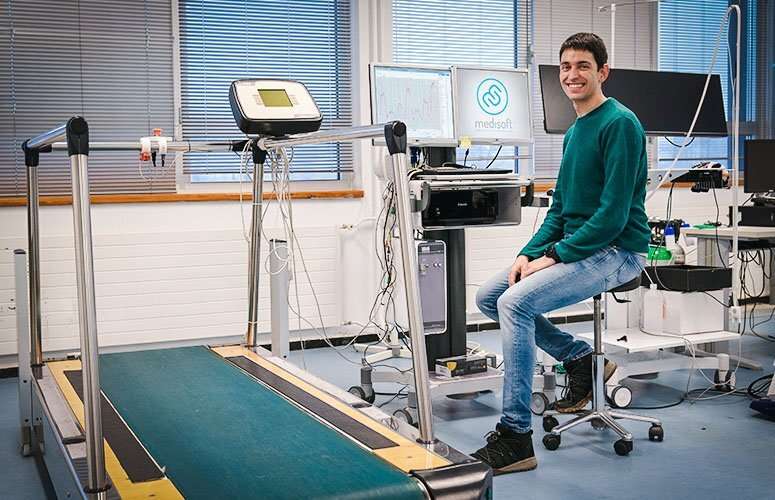This article has been reviewed according to Science X's editorial process and policies. Editors have highlighted the following attributes while ensuring the content's credibility:
fact-checked
trusted source
proofread
Examining impact of load on mountain rescuers

According to a University of the Basque Country (UPV/EHU) thesis, it may not be advisable for rescuers to carry loads greater than 20% of their body mass, as this may affect the success of their work
The Ph.D. thesis defended by Aitor Pinedo-Jauregi focuses on professional mountain rescuers, and aims to describe how the carrying of a backpack load exerts an impact on their physical performance when they have to carry out their work. For this purpose, he had the collaboration of rescuers from the mountain unit of the Surveillance and Rescue Section of the Ertzaintza [Basque Autonomous Community police service].
Mountain sports are one of the most popular pursuits. Specifically, number one in Spain, according to the latest survey of sporting habits carried out in 2022, and number five in the Basque Country. What is more, the Spanish Federation for Mountain and Climbing Sports (FEDME) is ranked number four in terms of total number of licenses.
According to the latest data on accident rates published in the Basque Autonomous Community, mountain rescues have increased in recent decades. In 2021, the mountain unit acted on 620 occasions, 570 of which were rescues and 50 searches.
When accidents occur during sporting activities in the natural environment, if the injured person is unable to move by his or her own means or with the help of a companion, and needs to be rescued, this is usually carried out by teams specially trained in mountain rescues.
Depending on the type of accident and type of access, rescuers often have to carry rescue equipment, which may influence their physical performance and the success of their mission; this is in addition to other external factors (altitude, gradient, mass of the backpack, weather, etc.). When these factors are compounded by the hazardous situations of some of the rescues, the physical performance of the rescuers may be compromised, and their own safety may even be endangered.
"The performance of mountain rescue teams could be likened to that of elite sports teams, considering that the physical performance of both groups is considered to be critical with respect to their ultimate success. So it is necessary to know the physical performance of the rescuers, as well as the special features of the rescues that affect their performance," says the researcher.
Thesis conclusions
In light of the research carried out, Aitor Pinedo concludes that in the scientific literature different protocols with different characteristics are used, and this makes it very difficult to compare studies on the subject. However, it has been shown that both the gradient and the mass of the rucksack exert an additional influence on the physiological and perceptual variables studied.
He therefore recommends that mountain rescuers should not carry loads equal to or greater than 20% of their body mass in their backpacks. "Carrying loads below this threshold allows them to walk on slopes with gradients of up to 20% without their physical performance being unduly compromised. Rescue teams will be able to consider this aspect when designing or modifying existing protocols," says Pinedo.
Moreover, a Stryd device was used for the measurements taken in the laboratory of the UPV/EHU's Faculty of Education and Sport; this device monitors the accelerations and decelerations of the foot, estimating instantaneously to a certain extent the mechanical power at which one is running. In addition, the device is able to monitor spatio-temporal parameters, such as cadence. As power is related to the intensity of the exercise, it allows power training to be carried out, which means being able to analyze and monitor the effort made during the activity.
"It has been demonstrated that the Stryd device can be used for measuring stride cadence during walking at different positive gradients and with different backpack masses in scientific research carried out in the lab. This can also mean a reduction in the cost of purchasing treadmill gait analysis devices," Pinedo concludes.
This innovative line of research could be applied to other emergency groups in which motor skills are an essential part of their work, such as mountain rescue groups or firefighters. The aim would be to analyze the work of these groups from a high-performance perspective, as in the case of elite sportsmen and women.
Related research has been published in Applied Ergonomics, International Journal of Industrial Ergonomics and Gait & Posture.
More information: Aitor Pinedo-Jauregi et al, Physiological stress in flat and uphill walking with different backpack loads in professional mountain rescue crews, Applied Ergonomics (2022). DOI: 10.1016/j.apergo.2022.103784
Aitor Pinedo-Jauregi et al, Protocols used to determine the influence of backpack load on physiological variables. Systematic review, International Journal of Industrial Ergonomics (2021). DOI: 10.1016/j.ergon.2021.103227
Aitor Pinedo-Jauregi et al, Reliability and validity of the Stryd Power Meter during different walking conditions, Gait & Posture (2021). DOI: 10.1016/j.gaitpost.2021.11.041





















